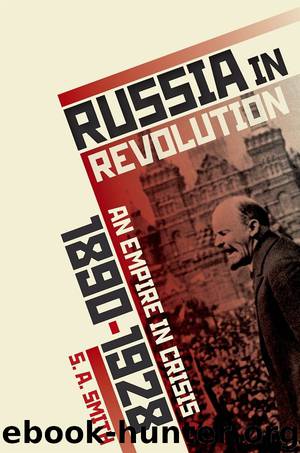Russia in Revolution by S. A. Smith

Author:S. A. Smith
Language: eng
Format: epub
ISBN: 9780191054044
Publisher: Oxford University Press
Published: 2016-11-29T05:00:00+00:00
Social Order Overturned
The crime wave that began in 1917 soared during the civil war. During the October seizure of power there had been orgies of drunkenness as soldiers ransacked wine stores and looted shops, and in 1918 the incidence of robbery and murder in Moscow was estimated to be ten to fifteen times the pre-war level.28 Those involved were professional gangs and bandits, who used the class war against burzhui to enrich themselves, along with a large number of deserters and refugees. However, many ordinary people also turned to crime in the struggle to survive. There were daily reports in the press of hideous mob lynchings (samosudy) by desperate civilians, directed against thieves and, especially, those suspected of hoarding. As one newspaper put it: ‘Mob justice occurs when there is no justice, when the people has lost confidence in government and the law.’ These acts of violence were often spectacularly barbaric, with a strong antisemitic tinge. In a huge riot in Kazanskaia stanitsa in Kuban’ in early 1918 forty presumed speculators were killed, four of whose bodies were quartered.29 Crime was facilitated by the weakness of the militia and the widespread availability of weapons. From the first the Bolsheviks made no bones of the fact that they were determined to stamp out crime. On 27 October 1917, the Military-Revolutionary Committee in Moscow, having taken steps to seize stocks of weapons, warned that ‘any attempt at a pogrom, any attempt at robbery or riot, will be crushed with the most merciless measures’.30 Within weeks the new regime restored capital punishment and Lenin began to make minatory noises about the need for an ‘iron hand’ to suppress lawlessness.
At the same time, and in a rather different spirit, the incoming government abolished the old court system—seen as a linchpin of the tsarist order—and pledged to construct a system of ‘proletarian justice’. The courts, the procuracy, and the bar association were abolished and in their place people’s courts were set up, comprising an elected judge and two lay assessors, all drawn as far as possible from the working classes. Marked leniency was shown towards criminals from the ‘toiling classes’. Juvenile courts and prison sentences for the under-17s were abolished, juvenile crime being handled by special welfare commissions. The system of courts gradually bedded down, but since a new Criminal Code was not drawn up until 1922, the people’s courts continued to rely mainly on the pre-revolutionary law code except where specific laws were repealed. Over the course of the civil war local commissariats of justice were gradually brought under the control of the Commissariat of Justice, and the influence of local soviets was reduced. According to the Commissariat of Justice, in 1920 popular courts dealt with only 22.3 per cent of criminal cases.31 Of 582,571 people found guilty, only one-third were given prison sentences, and of these about 40 per cent were suspended.32
The majority of criminal cases were dealt with by new ‘revolutionary’ organs, notably the revolutionary tribunals (which dealt with 35.3 per cent of criminal cases in 1920), by the Cheka (which dealt with 30.
Download
This site does not store any files on its server. We only index and link to content provided by other sites. Please contact the content providers to delete copyright contents if any and email us, we'll remove relevant links or contents immediately.
| Africa | Americas |
| Arctic & Antarctica | Asia |
| Australia & Oceania | Europe |
| Middle East | Russia |
| United States | World |
| Ancient Civilizations | Military |
| Historical Study & Educational Resources |
Red Famine: Stalin's War on Ukraine by Anne Applebaum(2816)
Chernobyl by Serhii Plokhy(2438)
Midnight in Chernobyl by Adam Higginbotham(2391)
The House of Government by Slezkine Yuri(2105)
Midnight in Chernobyl: The Untold Story of the World's Greatest Nuclear Disaster by Adam Higginbotham(2079)
Red Shambhala by Andrei Znamenski(2072)
The Gulag Archipelago (Vintage Classics) by Aleksandr Solzhenitsyn(1985)
All the Kremlin's Men by Mikhail Zygar(1962)
From Cold War to Hot Peace by Michael McFaul(1940)
Red Notice by Bill Browder(1929)
Putin's Labyrinth(1902)
The Future Is History by Masha Gessen(1822)
From Russia with Lunch by David Smiedt(1797)
A People's Tragedy by Orlando Figes(1768)
The Romanovs by Simon Sebag Montefiore(1723)
How to Tame a Fox (and Build a Dog): Visionary Scientists and a Siberian Tale of Jump-Started Evolution by Lee Alan Dugatkin & Lyudmila Trut(1680)
Putin's Labyrinth: Spies, Murder, and the Dark Heart of the New Russia(1664)
The Lost Spy by Andrew Meier(1634)
Art and Revolution by John Berger(1607)
